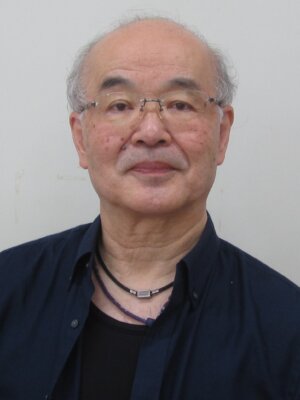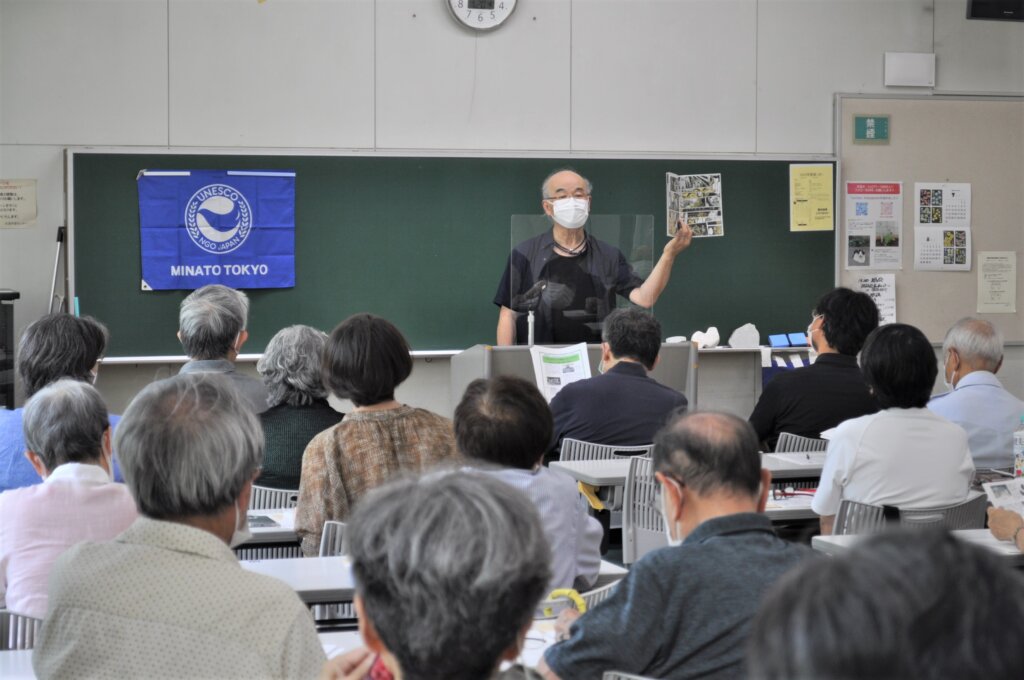Stone Culture: Hakone, Yugawara and Atami have more than Hot Springs to offer
Minato UNESCO Salon for SDGs
Stone Culture: Hakone, Yugawara and Atami have more than Hot Springs to offer
Instructor: KATO Masayoshi
Date: Wednesday, July 20, 2022
Venue: Minato City Life-long Learning Center, #305

Mr. Kato is a member of the compilation committee of Yugawara Town History; Director of Dohi-kai; Head of Ino Tadataka Research Group; Head of Yugawara-produced White Quarry Stone Research Group; Head of Preservation Society for Actual “Zuso Jinsha Railway (a tram car pushed by men)”. He completed master’s course, Chuo University. He currently lives in Yugawara.
Mr. Kato talked about “Stone Culture of Edo and Tokyo” from a viewpoint of “Yugawara”, a place of his second life. After retiring from a teaching job at a Saitama high school, he moved to Yugawara where he has explored “the warp and woof of history”. Mr. Tanabe, the president of Minato UNESCO Association, made an opening remark and introduced Mr. Kato to the audience. Using the 17-page materials that he kindly prepared for the lecture, Mr. Kato spoke to us in a carrying voice.
“Stone Wall” and “Embankment“
In 2021, the stone-related discoveries became hot topics. One was stone walls believed to be part of the early Edo Castle built by Shogun Ieyasu 400 years ago. Another was the sea embankment, found near Takanawa Gateway Station, which was constructed 150 years ago (in 1872) to run the steam locomotive.
From Edo Castle to Daiba, Railway, and Modern Buildings in Tokyo
Heavily used were Izu-Stones, Komatsu-Stones, and White Quarry Stones, all produced from places along the eastern coast of Izu Peninsula, including Odawara, Hakone, Manazuru, Yugawara, Atami, Taga, and Ito.
①Early Edo Period = Stones procured for walls of Edo Castle and for landfill of downtown Edo were sent from
Odawara and the whole areas of Izu Peninsula.
②Late Edo Period = Nishino-maru section of Edo Castle, which was burnt down in a large-scale fire,
was reconstructed by Odawara clan alone.
③Last years of Edo Period = Before Commodore Perry arrived, Edo Shogunate built batteries using stones from
Manazuru and Atami, in an emergency effort to drive away foreign ships.
④With the opening of the country and the collapse of the Shogunate, those forts became redundant.
Their stones, as well as those of Daimyo’s mansions, were converted to different uses, namely for “modern
architecture” and “railway”.
⑤Mid-Edo Period ~ last years of Taisho Period = White quarry stones from Yugawara were used as corner stones
and Koshidaka wall for the “Fukaya brick” buildings which are well known for its connection with Shibusawa Eiichi.

White Quarry Stones found in modern buildings in Tokyo
Next to Yugawara Baien “Makuyama”. White-color stones were formed as volcanic ash was piled up and solidified. They are not as heavy, strong, or as firm as white granite. Their sticky quality helps prevent crack even when piercing a hole. What’s more, they were craft-friendly and could be easily processed into thin plates, thereby coming in handy for decorating walls. Finding out that marble was not available in Japan, architects who have studied western architecture abroad decided to use white quarry stones as alternative material. Examples include: Bank of Japan Head Office (right photo), Yokohama Specie Bank (now Kanagawa Prefectural Museum of Cultural History), Ueno Imperial Library (now International Library of Children’s Literature) and First Block of Mitsubishi Co. Building before restoration work. Even today we can see and touch white stones, although many of these buildings were destroyed in the Great Kanto Earthquake.
“Study of two men” has proved to be a great help in his stone research.
Ino Tadataka’s survey team created the map of Japan, and chronicled the process in the “Survey Journal”. Mr. Kato has thoroughly read the Journal and noticed that the team passed through Yugawara three times. 1801: On its second survey trip, the team stayed at “the Mukasa Family”, a headman of Yoshihama Village. 1816: On the 9th survey trip, the team had lunch at “the Tomioka Family”, a headman of Mongawa Village, who is said to be a descendant of Dohi-no Sanehira. After lunch, they visited the grave of Dohi Family.
Mr. Watanabe Takeshi, who is the Hakone Geopark guide, stated in his thesis on “the Folding Screen depicting Stone Quarry” that stones used for the reconstruction of the Nishino-maru section of Edo Castle were carried down to the seashore by oxcarts and then loaded onto the boat. The project was conducted by Yoshihama Village headman Mukasa by the order of Lord Ohkubo, Odawara clan. In 2021, Mr. Kato narrowed down the time of these operations to 1838 and 1839.
Dohi-no Sanehira Supported Lord Yoritomo
Dohi was a trusted aide because he helped Lord Yoritomo raise an army. Yugawara residents took pride in this fact and thus erected a bronze statue of Dohi-no-Sanehira and his wife. Joganji, the family temple, still stands today, and Sanehira himself was portrayed in the popular TV drama “The 13 Lords of the Shogun”. “Dohi-kai”, a group with an aim to honor Sanehira, organizes such events as Dohi festival, warrior parade, and “Johmoh-no Mai”. Mr. Kato has been supporting this group’s activities for longer than a decade. His study has expanded further to include Mihara Kobayakawa, a descendant of Dohi clan, Mr. Shinkai of Fukaya, to Toyama, Kanazawa , Anan, and Yokote. These field trips overlapped with the courses taken by Basho and Tadataka, thereby beefing up horizontal connections with “the Survey Journal” study.

Conclusion
Mr. Kato used to hold open lectures on “Traveling Basho” even before retirement, as he privately admired Basho. Then he expanded his research to include Ino Tadataka, as well as Sanehira whom he encountered in Yugawara. Finding out that all three of them worked very hard in their second life, Mr. Kato realized that his own second life should be devoted to conveying the history of “great people in local community” and “stone culture” to the next generation.
Based on his hands-on approach, Mr. Kato called out to people, “Visit the historical sites” and “read aloud the great historical masterpieces”. After retirement, proving that he is a man of action, Mr. Kato visited various sites and read volumes of literature, thereby reinforcing his vertical and horizontal perspectives on history. Mr. Kato also worked successfully on the city of Yugawara to build three stone monuments honoring “the Ino Tadataka Survey Team”, a big achievement for people wanting to pass on the historical facts to the next generation. If you are interested in his activities from now on, please see his blog on the Internet.
(Written by KOBAYASHI Takayuki, Vice President, the Membership Committee, and translated by MIYASHITA Yukari, Standing Director, the PR & Internet Committee)
